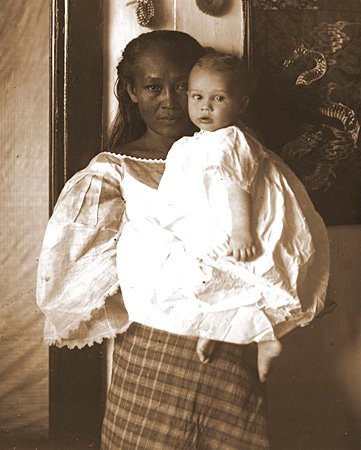Cultural Center of the Philippines
ENCYCLOPEDIA OF
PHILIPPINE ART
Captain Alex Davis' Child and Nurse
Between 1898 and 1907 / Photo no. 27 of the album “Poses and Exposures,” The Philippines Through the Lens of an American Soldier: The Harry Harnish Photographic Collection / Artist: Harry Harnish / The University of the Philippines Main Library collection.
From 1898 to 1907, Harry Harnish (1869-1960), a United States (US) Infantry private on tour of duty, and his wife took photographs of the Philippines. The photographic collection offers interesting views on American observations of the country and attendant senses of self in a new and colonized territory.
The picture of an American captain’s child with her Filipina nursemaid presents a charged representation of colonial relations that obtained during the period. A yaya (nursemaid) carries the daughter of her master. As denoted by the title, it is the child that is the subject of the photograph and the Filipina maiden is only an appendage of this subject. They wear formal dresses for the camera, the native baro’t saya for the nursemaid and a dress for the captain’s daughter.
Still regarded as relatively new technology in the country then, the camera traveled across wide areas, crossed boundaries, and, with this photograph, entered the private space of a public official. Aspects of his domesticity are captured by the camera. The child and her nurse are rather formal, but there is a hint of gentleness as the child’s head slightly touches that of the woman. Perhaps there is an intimacy that lurks beneath the surface and beyond the camera’s gaze. The woman is not smiling, but not scowling either; there is a degree of dignity that is fixed or recorded. In the history of art, their pose resembles the “mother-and-child” motif with a perplexing twist when taken in light of the nation’s new context: racial and imperial difference complicating the apparent tenderness.
The blunt contrast in skin color—the almost black native woman and the sheer whiteness of the child—also sharpens the differences of these subjects amidst colonial relations. It is as though the child emerges from the backdrop as a distinct form and yet as one that is dependent on what surrounds her to make her present. Attending to their respective duties, the officer and his wife rely on this poor maiden to take care of their household. The presumably backward woman-native-other, who belongs to the country recently subjugated by the US invader, rears the precious child of an American military man, testifying to subaltern labor that sustains the empire’s future and supporting the master-slave relations under America’s “Benevolent Assimilation.”
Written by JPaul S. Manzanilla (2018)
Source
NCCA (National Commission for Culture and the Arts) and the Art Studies Foundation. 2004. The Philippines through the Lens of an American Soldier: The Harry Whitfield Harnish Photographic Collection. Edited by Gerard Ray Lico. CDROM. Manila: NCCA, Art Studies Foundation Inc, and the University of the Philippines Library.
